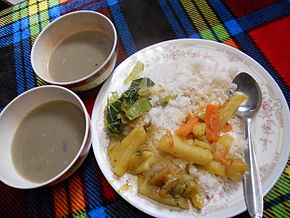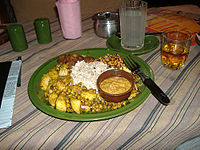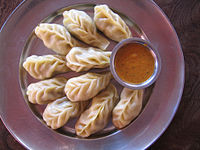- Nepalese cuisine
-
Nepalese cuisine refers to the cuisines of Nepal. The cultural and geographic diversity of Nepal provide ample space for a variety of cuisines based on ethnicity, soil and climate. Nevertheless dal-bhat-tarkari (Nepali: दाल भात तरकारी ) is eaten throughout the country. Dal is a soup made of lentils and spices. It is served over boiled grain, bhat -- usually rice but sometimes another grain -- with vegetable curry, tarkari. Typical condiments are a small amount of extremely spicy chutney (चटनी) or achaar (अचार). These can be made from fresh ingredients, or may be a kind of fermented pickle. The variety of these preparations is staggering, said to number in the thousands.[1] Other accompaniments may be sliced lemon(kagati) or lime (nibua) and fresh chili peppers, khursani.
Contents
Types
- Newari cuisine - Newars are an ethnic group originally living in the Kathmandu Valley, now also in bazaar towns elsewhere in the Middle Hills (Himalayan foothills, up to about 6,500'/2,000m). Water buffalo meat is eaten by Newars but avoided by most observant Hindus as too cow-like. Nevertheless, less observant urbanized Hindus may in fact eat buffalo in the form of momo (potstickers) and other dishes in Newari restaurants. Newari cuisine has many fermented preparations. In the fertile Kathmandu and Pokhara valleys where cheap rice can be trucked in and local market farmers find produce more profitable than grain, the cuisine is much more varied than in more isolated parts of the Hills where maximizing grain production is still a matter of survival.
- Khas or Pahari cuisine conforms to dietary restrictions of upper-caste Hindus in the Middle Hills. Dal-bhat-tarkari is the standard meal eaten twice daily.Hill Bahun (Brahmins),Chhetris Have traditionally eaten Goat meat(Khasi)and fish. However with land suitable for irrigated rice paddies in short supply, other grains supplement or even dominate. Wheat becomes unleavened flat wheat bread (roti or chapati). Maize (makai), buckwheat (fapar), barley (jau) or millet (kodo) become porridge-like (dhiro or ato). Tarkari can be spinach or greens (sag), fermented and dried greens (gundruk), daikon radish (mula), potatoes (alu), green beans (simi), tomatoes (golbeda), cauliflower(kauli), cabbage (bandakopi)), pumpkin (pharsi), etc. Fruit traditionally grown in the hills include mandarin orange (suntala), kaffir lime (kaguti), lemon (nibuwa), asian pear (nashpati), and bayberry (kaphal). Yoghurt (dahi) and curried meat (masu) or fish (machha) are served as side dishes when available. Chicken (Kukhura), and fish are usually acceptable to all but the highest Brahmin (Bahun) caste, who limit meat to Goat (Khasi). Observant Hindus never eat beef (gaiko masu), except untouchables (dalit) possibly eating animals that have died of natural causes. In Pahari communities, domestic pork (sungurko masu) was traditionally only eaten by Magars, Kirats and Dalits, However bangur ko masu wild boar was traditionally hunted and eaten by Chhetris. A strain derived from wild boar is now raised in captivity and used for meat that is increasingly popular with Pahari ethnicities and castes that did not traditionally eat pork.
- Ethnic variations in the Middle Hills - buffalo meat and/or pork are eaten by many janajati -- indigenous nationalities with customs departing from Hindu norms to varying degrees. In the course of the Nepalese Civil War, Magars (and perhaps other ethnicities in areas under rebel control) began eating beef to flaunt longstanding Hindu domination. More traditionally, Magars ate pork but not water buffalo while the superficially similar Gurung did the opposite. Further east, Tamang, Rai and Limbu have unique ethnic foods including fermented soybeans, yangben -- a particular type of moss, preparations of bamboo shoots, bread made from millet or buckwheat, and traditional Limbu drink tongba (millet beer).[2][3]
- Terai cuisine - Food in Outer Terai south of Sivalik Hills grades into cuisines of adjacent parts of India such as Maithili[4] cuisine in the east, Bihari and Bhojpuri cuisine in the center and near west. Further west there is Uttar Pradeshi and even Mughlai-influenced Awadhi cuisine -- particularly eaten by the substantial Muslim population around Nepalganj and beyond. Terai diets can be more varied than in the Middle Hills because of greater variety of crops grown locally plus cash crops imported from cooler microclimates in nearby hill regions as well as from different parts of India. Fruit commonly grown in the Terai include mango (aam), litchi, papaya (armewa/papeeta), banana (kera/kela) and jackfruit (katahar/katahal).
- Inner Terai valleys between the Sivaliks and Mahabharat Range were originally severely malarial and mainly populated by genetically-resistant Tharu who mave a distinctive (but not well documented) cuisine. Tharu certainly consume large amounts of fish from local rivers and are even said to eat rats & snails, which is eaten by few other castes in terai as well. Control of malaria starting in the late 1950s enabled immigration by land-hungry settlers from the hills and by Indian merchant families into towns, bringing their respective native cuisines with them.
- Himalayan cuisine - Eaten by culturally Tibetan and closely related ethnic groups in the Himalaya and Trans-himalaya. Buckwheat), barley and millet are important cold-tolerant grains often processed into noodles or tsampa (toasted flour), or made into alcoholic beverages (see below). Potatoes are another important staple crop and food. Subtantial amounts of rice are imported from the lowlands. The meat of yak and possibly yak-cow hybrids may be used, as well as their milk. Meat is often prepared as momo (potstickers).
- Thakali cuisine - transitional between Himalayan and lowland cuisines, eaten by Thakali people of Tibetan affinity who settled in Thak-Khola Valley, an ancient and relatively easy trade route through the high Himalaya. Yak and Yak-cow hybrids locally known as Jhopa were consumed by the lower castes. Two types of sheep known as Bheda and Chyangra or Chiru were imported from Tibet proper. Thakali cuisine also uses locally-grown buckwheat, barley, millet and dal as well as rice and dal imported from lower regions to the south. Since most Thakali people were engaged in trade, they could import vegetables and fruits etc. from lower regions. A large variety of vegetables were consumed daily, some -- especially radish and beetroot -- dried and often prepared with mutton. Soup prepared from spinach known as 'gyang-to' was served with a pinch of timur-ko-choup a condiment prepared from red chili powder, black pepper, salt and local herbs. Thakali cuisine is popular in the cities of Nepal with a number of eateries in Kathmandu and Pokhara.
- Snacks include maize popped or parched called khaja (literally, "Eat and run."); beaten rice (chyura), dry-roasted soybeans (bhatmas), lapsi (dried fruit candy), samosa - turnovers stuffed with meat or vegetables, biscuits (packaged cookies) and Indian sweets. Instant noodles manufactured with Indian spices are coming into widespread use.
- Beverages - tea (chiya) usually taken with milk and sugar, juice of sugarcane (sarbat) and buttermilk (mahi). Alcoholic beverages include raksi, spirits made in rustic distilleries, and jard, homemade beer made from rice. At higher elevations there is millet beer (tongba or chyang).
Etiquette
Meals are traditionally eaten seated or squatting on the floor, although urban restaurants have tables and chairs. A large mound of bhat (boiled rice or other grain such as cornmeal or barley) or a pile of roti (rounds of thin unleavened bread) is served on a thali -- a rimmed brass or stainless steel plate about 12"/30cm. diameter. The rice is surrounded by smaller mounds of prepared vegetables, fresh chutney or preserved pickles, and sometimes curd, fish or meat. Soup-like dal and vegetables cooked in sauce may be served in separate small bowls, to be poured over the rice. Food is brought to the mouth with the fingers of the right hand. The left hand -- traditionally used for certain toilet purposes -- should never touch food but may hold cups and glasses. The right hand should be rinsed before and after eating.
Traditional Hindu food etiquette is deeply concerned with caste and ritual pollution. Water and foods cooked in water -- especially grains, dal and vegetables -- are polluted by the touch of a person of lower caste than the person who consumes them, or of anyone who has become unclean by not bathing and putting on clean clothes after polluting events such as defecation or menstruation. The cook should otherwise be a housewife (who is not lower caste than her husband) or a tagadhari -- high caste male wearing a sacred thread (janai). Once someone has started eating cooked food, it becomes polluted (jutho) to others, except a wife may eat leftovers from her husband's plate and children may eat both parents' leftovers.
Water itself is highly subject to ritual pollution, rendering containers as well as water polluting. Clay or wooden containers must then be discarded while metal containers require ritual scouring. You will often find people drinking water by pouring it into their mouths rather than touching their lips to the container. This avoids polluting the container and any water remaining inside.
Dry-cooked grains -- including beaten rice and roasted soybeans or corn -- also rice pudding cooked in milk rather than water (khir) and raw fruit are less subject to ritual pollution. These foods can be accepted from any clean caste but not from untouchables.
Foreigners and members of many janajati -- indigenous ethnic groups that not formally absorbed into the orthodox caste system -- occupy an ambiguous space. They are neither fully untouchable nor fully "clean". They may not be welcome inside upper-caste homes and should not presume to enter without being invited (and not just invited to sit outside on the porch). Upper-caste Hindus may decline to eat with them at all, or may avoid eating foods that are most subject to pollution.
Breaches of dietary etiquette were made criminal offenses in Muluki Ain -- the main corpus of civil law -- in 1854 and not decriminalized until 1962. Since 1962 discriminatory customs have been falling into disuse among educated and urban Nepalis, yet they often prevail in the countryside, especially among older Brahmins and Thakuris. Guests and visitors should try to conform to traditional dietary customs until clearly instructed otherwise by their hosts.
References
- ^ "Pickle - Achar - Chutney". Food-nepal.com. http://www.food-nepal.com/ingredients/i009.htm. Retrieved 2010-09-12.
- ^ "?About Historical and Contemporary Limbu Women of Nepal?". Forum.welovenepal.com. 2008-06-24. http://www.forum.welovenepal.com/index.php?topic=7942.0;wap2. Retrieved 2010-09-12.
- ^ "The Sikkim cuisines". Indiatraveltimes.com. http://www.indiatraveltimes.com/sikkim/sikkim_cuisine.html. Retrieved 2010-09-12.
- ^ "Mithila Cuisine". Mithilacuisine.blogspot.com. http://mithilacuisine.blogspot.com/. Retrieved 2010-09-12.
See also
- South Asian cuisine
- Jimbu
External links
- Saidi, Nicole. "In search of Nepal's culinary identity." CNN. October 14, 2011.
- Eating in Nepal
- Nepali food recipes
- Nepali food
- Caste system and Hindu food etiquette in India
Asian cuisine Sovereign
states- Afghanistan
- Armenia
- Azerbaijan
- Bahrain
- Bangladesh
- Bhutan
- Brunei
- Burma (Myanmar)
- Cambodia
- People's Republic of China
- Cyprus
- East Timor (Timor-Leste)
- Egypt
- Georgia
- India
- Indonesia
- Iran
- Iraq
- Israel
- Japan
- Jordan
- Kazakhstan
- North Korea
- South Korea
- Kuwait
- Kyrgyzstan
- Laos
- Lebanon
- Malaysia
- Maldives
- Mongolia
- Nepal
- Oman
- Pakistan
- Philippines
- Qatar
- Russia
- Saudi Arabia
- Singapore
- Sri Lanka
- Syria
- Tajikistan
- Thailand
- Turkey
- Turkmenistan
- United Arab Emirates
- Uzbekistan
- Vietnam
- Yemen
States with limited
recognition- Abkhazia
- Nagorno-Karabakh
- Northern Cyprus
- Palestine
- Republic of China (Taiwan)
- South Ossetia
Dependencies and
other territoriesCategories:- Nepalese cuisine
- South Asian cuisine
- Newari cuisine
- Caste system by country
- Nepalese society
- Ethnic groups by country
- Ethnic groups in Asia
- Himalayan peoples
- Ethnic groups in South Asia
- Demographics of Nepal
Wikimedia Foundation. 2010.






